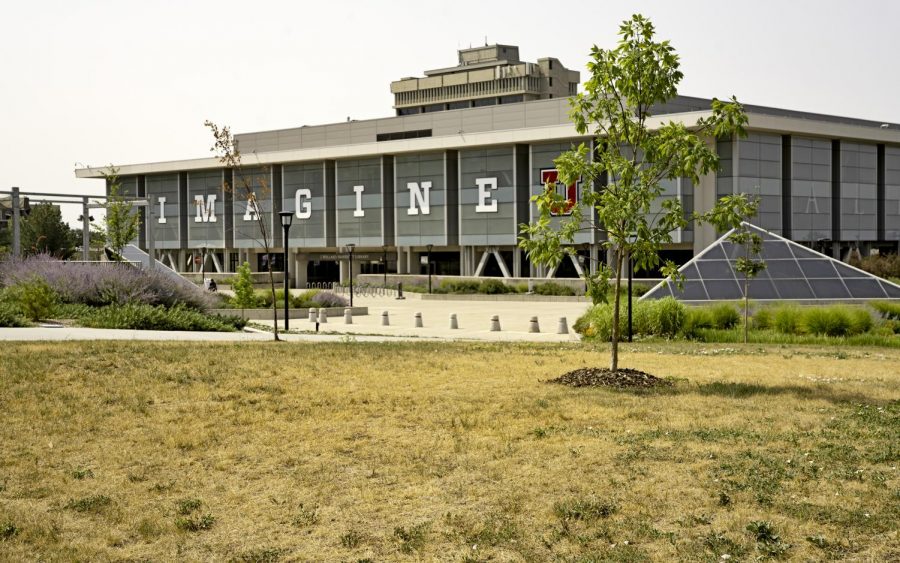Shadley & Soter: What’s Worth Watering?
The drought’s effect on campus with view towards the Marriott Library on July 24, 2021. (Photo by Kevin Cody | The Daily Utah Chronicle)
July 29, 2021
With the Great Salt Lake and surrounding areas reaching their lowest water levels ever, we must reevaluate where our limited water supply goes. The historic drought that has caused these low lake levels shows no sign of letting up. In response, Salt Lake County has asked residents to use 5% less water in the hopes of saving at least 2 million gallons per day. Yet, Salt Lake County continues to supply 9.05 million gallons of water to public golf courses daily.
The competing water demands make us question “what’s worth watering?” Because we can’t meet everybody’s water desires, we must divert water to the resources that provide the most community benefit. This deliberation fits into a larger discussion of how public resources impact the lives of all Salt Lake City residents, specifically the most vulnerable.
We recently wrote about the proposed Other Side Village, a tiny-home community for Salt Lake City’s chronically homeless population. The city has yet to find a location for the community, despite Mayor Erin Mendenhall’s hope to house residents by Nov. 1. With the water shortage, Mayor Mendenhall has a rare justification and an opportunity to simultaneously address two of Utah’s most pressing challenges.
Salt Lake City owns six of the 33 public golf courses in Salt Lake County, all of which use an average of 2,910 gallons of water per acre per day. If golf courses benefited the community at large, their water usage would be justified, but they don’t. Instead, they cater to a privileged, white male population of SLC. Golf courses allow a small population to use an outsized sum of resources. With the ongoing drought, maintaining all of Salt Lake City’s golf courses is no longer worth the water.
Glendale golf course, one of the courses owned by Salt Lake City, sits at roughly 185 acres. At 2,910 gallons of water per acre, Glendale requires 538,350 gallons of water every day. Salt Lake City considered closing Glendale Golf Course back in 2015 due to the anticipated deficits associated with running the course. While they ultimately decided to keep the course open, it’s far from a financial asset. Rather than continuing to operate a financial and ecological burden, Salt Lake City and Mayor Mendenhall should convert the Glendale Golf Course into a multi-purpose community center.
The Glendale Community Center could easily house The Other Side Village and the 400-500 individuals that would live there, with roughly 140 acres to spare. With the remaining space, the center could address the food insecurity crisis currently plaguing the surrounding community. The problem with living in a food desert, like Glendale, comes less from the inability to eat and more from the lack of fresh produce available.
The Urban Homestead Project produces 6,000 pounds of fresh produce annually on 1/10th of an acre. The average American eats 273 pounds of fruit and 415 pounds of vegetables annually. Using these urban gardening practices, each acre could provide enough produce for ~87 people each year. Replicating this model in the leftover acreage at the Glendale Community Center would yield enough produce for over 12,000 people.
This massive urban garden would give the residents of The Other Side Village a fulfilling job: providing food for their community. Their service would generate significant income for the village and two vital resources, fresh produce and a grocery store, to one of Salt Lake City’s food deserts. While the Glendale Community Center will undeniably require a significant amount of water, albeit less than a golf course, it’s a purpose worth watering.
When Salt Lake considered closing Glendale Golf Course, they were adamant that the land be kept under city control. Furthermore, they recognized that a multi-use facility would be the only worthwhile replacement. While those efforts ultimately failed, the sentiment remains: public resources should serve the public.
Salt Lake City has the opportunity to provide long-term shelter and employment for 400-500 of its chronically homeless residents, fresh produce to an entire neighborhood, an economic stimulus to one of Salt Lake’s lower-income communities and reduce water consumption. The alternative is to continue watering a golf course with questionable financial stability.
We’re glad we don’t have to make that incredibly difficult decision.










